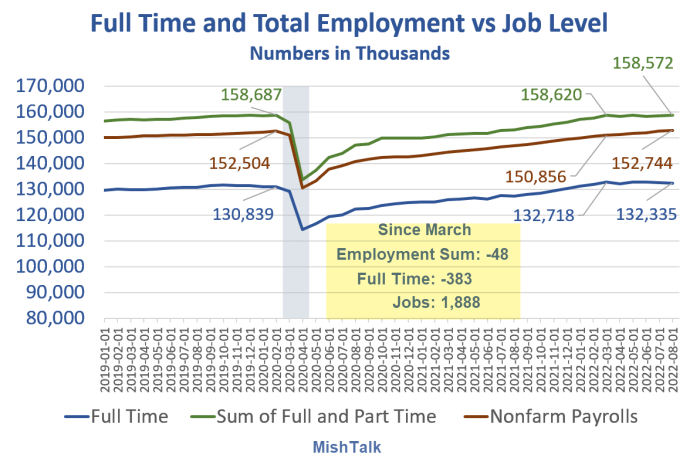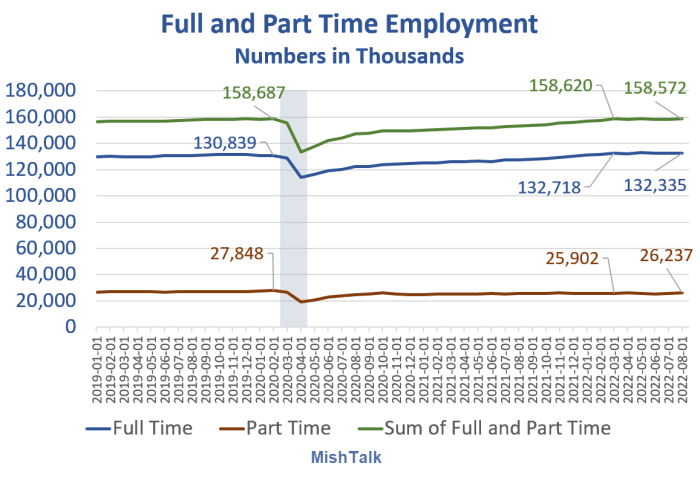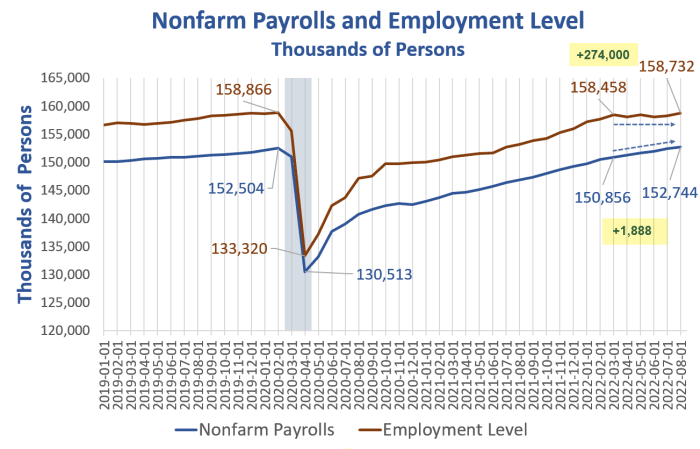I noticed earlier today The jobs report is much weaker than it looks for six months
I have been commenting on the discrepancy in jobs (NFA payroll) versus employment (household survey) for four months. The two surveys measure different things. Either a person is employed or not employed, but a person can have multiple jobs.
In general, the numbers move in the same direction over time. The family survey is noisy, but 6 months is a reasonable time frame for resolving discrepancies.
If you assume both surveys are correct, the explanation is that the strength in jobs since March is due to 1.6 to 2.0 million people working in additional part-time jobs..
The only other explanation is that one of the surveys is completely wrong.
This report is another attempt to explain the contradiction.
Household Survey vs. Salary Survey
The salary survey (sometimes called the enterprise survey) is the number of key jobs, and is generally released on the first Friday of every month. Depends on employer reports.
The Household Survey is a telephone survey conducted by the BLS. It measures unemployment and many other factors.
If you work one hour, you are an employee. If you do not have a job and fail to look for a job, you are not considered unemployed, you will drop out of the workforce.
Employment level versus total full-time and part-time employment
- Due to the way the BLS performs a seasonal adjustment, the sum of full-time and part-time jobs does not match the total employment level.
- However, these discrepancies are random and fluctuate equally in both directions per month by +-250,000. This is not a source of constant one-way discrepancy between trends.
Full time and part time
March 2022 Recruitment vs Jobs
- Full-time: 132.718.000
- Part time: 25902000
- Total full and part time: 158,620
- Non-farm payroll: 150856000
August 2022 Recruitment vs Jobs
- Full-time: 132,335.000
- Part time: 26,237,000
- Total full and part time: 158,572,000
- Non-farm payroll: 152,744,000
March to August change
Go to follow
- Full-time: -383000
- Part time: +335000
- Total part-time and full-time: -48000
- Non-farm payroll: +1,888,000
March to August key points
The economy added 1,888,000 jobs while full-time employment decreased by 383,000 and total employment (according to the sum of full and part-time) decreased by 48,000.
The sum of the discrepancy between the directions is 1,888,000 + 48,000 = 1,936,000
Non-farm payroll and employment level
What is happening?
You’ll get a slightly different number if you compare the level of employment to non-farm payroll (rather than the sum of full-time and part-time employment) as you did above.
The latter method shows a surplus of 1.614 million jobs versus employment gains while the sum of parts method has 1.936 million discrepancies.
A possible explanation for the differences is the boom retirements along with nearly two million people working extra part-time jobs to make ends meet due to high inflation.
Regardless of the interpretation, if the Home Jobs and BLS reports are reasonably accurate, the heavily promoted job boom is grossly exaggerated in any practical sense, especially real consumer spending.
Don’t expect strong spending based on strong jobs because the data suggests this is a mirage of part-time work force (less than an extra 8-hour shift or less).
This post originated in MishTalk.Com
Please subscribe!
Such reports? I hope so, and if you do, please Subscribe to MishTalk Email Alerts.
Subscribers get an email alert for every post as it happens. Read what you like and you can unsubscribe at any time.
If you subscribe and don’t get email alerts, please check your spam folder.
can’t you


